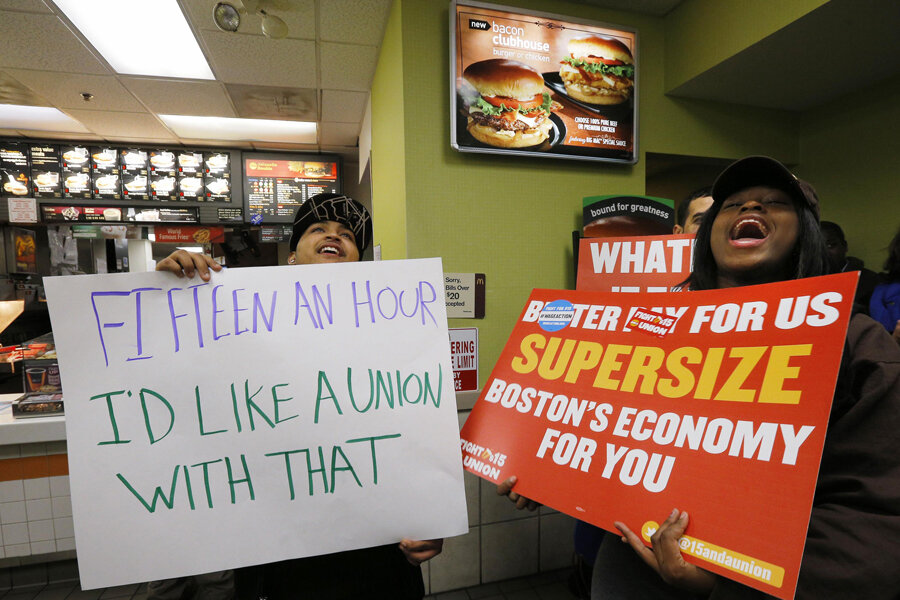As workers strike again, the 'Fight for $15' expands its political horizons
Loading...
Fast-food workers across the country kicked off a fresh round of strikes Thursday, walking off the job in a reported 190 cities in support of a $15 hourly minimum wage and the right to join a union.
At this point, calling them “fast-food worker strikes” is a bit of a misnomer. Now entering its third year, the protests, part of what has become known as the “Fight for $15,” have grown from just a few dozen cities in 2012 to a couple hundred. Some restaurants have closed temporarily and workers are marching in several cities, including Washington, D.C., and Buffalo, N.Y. They’re also more wide-ranging, expanding from food service and retail to include virtually any nonunion, minimum wage work.
Thursday’s strikes come a week after the latest round of retail worker protests on Black Friday, another branch of the minimum wage movement that shares many of the same organizers as the fast food protests. Earlier in the fall, home health aides protested in several cities, joining again Thursday. “In many cities, home care workers will protest Thursday alongside their clients,” read a release from Berlin Rosen, the ad agency that has helped organize the protests.
Low-wage airport workers including baggage handlers and aircraft cleaners also joined in the protests. “Like many other airport workers, I make only minimum wage with no benefits,” Abera Siyoum, a disability cart driver at Minneapolis-St. Paul International Airport, said in a press statement. “When I look at the fight of fast-food workers, I see my fight. We live in the same community and suffer the same problems and that’s why we’re all fighting to make a change.”
But in addition to other industries, the Fight for $15 has started to align itself with political issues beyond wage inequity. The protests in Ferguson, Mo., in the wake of the Michael Brown grand jury decision targeted Wal-Mart and other retailers on Black Friday, giving already planned wage protests an extra edge. On Wednesday, Wal-Mart workers protested at the Supreme Court as it heard oral arguments in Young v. United Parcel Service,the case of a UPS worker placed on forced unpaid leave when she became pregnant. Today's strikes coincide with nationwide protests over a nonindictment in the case of Eric Gardner.
Taking up such causes can be risky, says David S. Meyer, a sociology professor who studies protest movements at the University of California in Irvine. There’s the danger of seeming opportunistic, and certain issues (he cites abortion as an example) can be alienating to large groups of potential supporters. “I’m sure [the organizers] are having serious debates around the table about this,” he says in a phone interview. "But they’re hopping on news that they see as connected to the issue of inequality. Racial justice and policing fit pretty well given the profile of most minimum wage workers.”
So far, he says, Fight for 15 has been smart about finding ways to keep its message fresh but not muddled. “They started with a very specific, clear demand [$15 an hour minimum wage], and are adding on issues without losing track of the main focus. Broad claims about justice always have the context of specific policy demands.”
The food industry and retailers, by and large, have continued to be dismissive of the protests. The National Retail Federation has called them “orchestrated theater,” by labor unions trying to boost membership. Wal-Mart’s public relations department has set up ourwalmartfactcheck.com, a website dedicating to discrediting claims made by the protesters.
Still, wage increases have already found some success on a political level: Several cities, states, and retailers have raised their minimum pay over the past year, and Democrats including Hillary Clinton and President Obama have championed the cause. “They’re making inroads in friendly venues and using that as a base to engage more workers,” Mr. Meyer notes. "If they’re successful, new actors take up the issue. When you get other groups and mainstream politicians to do your work for you, that’s when you win.”






